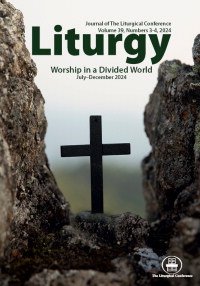In the Current Issue: "From Division to Encounter"
The issue of Liturgy entitled “Worship in a Divided World,” guest-edited by Benjamin Durheim, seeks to explore where our worshipping communities stand with regard to divisions that have pulled Christian worship patterns in divergent directions both negatively and, especially in recent times, positively as strengths. This excerpt is part of Hansol Goo’s essay “From Division to Encounter: Spatial Considerations for Hospitality in Shared Parishes,” explaining conclusions she and others have drawn from research with immigrant congregations worshipping in established churches of ethnic and racial communities not their own. –– Melinda Quivik
~ ~ ~ ~ ~
Division is often rife in a shared parish, whether in the area of communication, hierarchical structure, or administration. But one of the most prominent ways in which division is experienced at a shared parish is the space. A parish is not only a community of individuals but a physical building made up of walls, ceiling, and floor. Each time the parishioners gather, whether for liturgy or parish event, they gather in a physical space, and difficulties ensue among the parishioners who share the space. In a literal sense, shared parish means sharing the physical building space; division among the sharing communities lies not only in the perceived differences in each other’s culture, but in the concrete experience of spatial division that separates the communities. For example, spatial division is acutely felt when two communities belonging to the same parish cannot celebrate liturgy together in the same worship space due to linguistic and cultural differences. . .
To accommodate the needs of each community to celebrate the liturgy in their own language, multiple masses are held at different times on Sundays and feast days by congregations that are ethnically separated from one another. Independent and therefore unaware of each other, members of each community are insulated within their ethnic group and do not interact with others outside of their group. Like oil and water, ethnically distinct communities within the same parish do not mix and they exist in parallel worlds that do not cross.
Space becomes a point of contention because the minority community in a predominantly white-American parish often experiences unequal treatments regarding access and use of the worship space. . . As one Vietnamese pastor put it: “they give the Vietnamese people the spare time that they [the white, English-speaking parishioners] don’t use.” Being given an unfavorable or inconvenient time for Sunday mass, the minority community often feels that they do not have authority or power to use the worship space according to their preference. This includes not only the preferred time to use the space but also decoration, arrangement of the furnishings and audio equipment in the worship space, or display of the community’s devotional statues and images. The typical expression used among the members of the dominant community of the parish is that the minority community “borrows” the church space at the parish where they (do not) belong. . .
Being established as a parish often indicates that an immigrant community has aquired enough financial resources and the permission from the bishop to build a new church building of their own. Erecting a new parish is a milestone that marks that the immigrant community has now taken roots in the foreign land. They are no longer a wandering group worshiping in borrowed spaces but a proper parish with a church building where they can establish themselves with permanence. A physical building augments the community’s self-understanding as an officially sanctioned parish community. Thus, worshiping and holding parochial activities in a space of their own means that the community becomes visible in the pastoral landscape of the diocese.
~ ~ ~ ~ ~
Hansol Goo is Assistant Professor of liturgical theology in the School of Theology at College of Saint Benedict and St. John’s University in Collegeville, Minnesota. Her research areas include liturgical and sacramental theology, theology of migration, ritual studies, global Catholicism, and Christian art and architecture.
Hansol Goo, “From Division to Encounter: Spatial Considerations for Hospitality in Shared Parishes,” Liturgy 39, nos. 3–4 (2024): 93–100, https://doi.org/10.1080/0458063X.2024.2369024.
